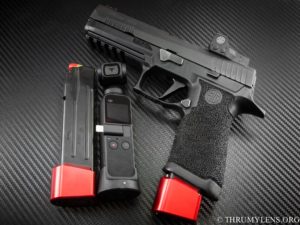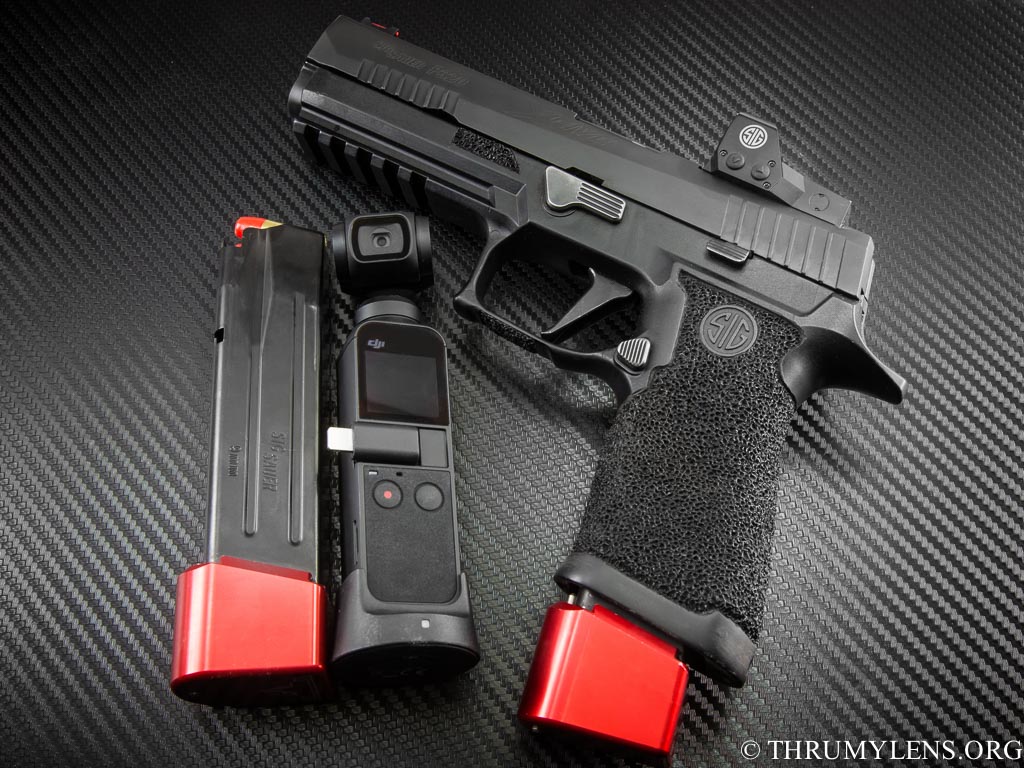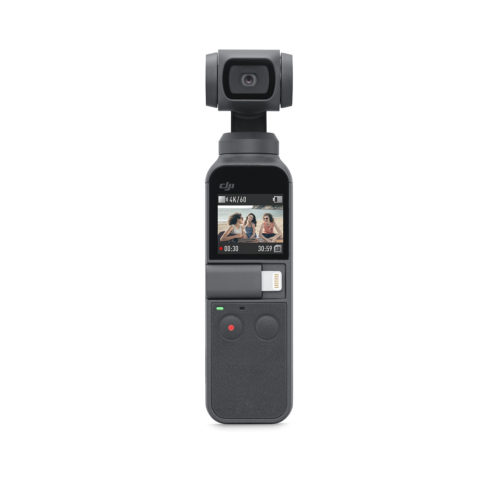 Getting good video footage from a match is important to many competitive shooters. Many sponsored shooters use match video footage to highlight the performance of their sponsor’s products on social media, and to help the shooter aquire new sponsors. Match video can also be great to post and share within the community – a memento that can be seen for years to come as a reminder of all the great memories and performances from the match. Even if the video footage isn’t posted, match video can help identify problems that can be improved upon in practice and training. Like most competitors, my go-to device for capturing match video has been my phone – currently an iPhone Xs. Mobile phones work reasonably well, but there are devices that can function even better to help capture great match video – like the DJI Osmo Pocket.
Getting good video footage from a match is important to many competitive shooters. Many sponsored shooters use match video footage to highlight the performance of their sponsor’s products on social media, and to help the shooter aquire new sponsors. Match video can also be great to post and share within the community – a memento that can be seen for years to come as a reminder of all the great memories and performances from the match. Even if the video footage isn’t posted, match video can help identify problems that can be improved upon in practice and training. Like most competitors, my go-to device for capturing match video has been my phone – currently an iPhone Xs. Mobile phones work reasonably well, but there are devices that can function even better to help capture great match video – like the DJI Osmo Pocket.
There are no shortage of reviews out there for the DJI Osmo Pocket – the official DJI Osmo Pocket release date was back in December 15, 2018, following pre-orders that started as soon as the gimbal was announced on November 28. So I’m not exactly first out of the gate in evaluating this product – which is intentional. DJI rushed to get the Osmo Pocket out the door, and initial reviews of the product were tepid. In the months that have followed however DJI has released firmware updates which have solved a number of issues identified at the initial release. Additionally, DJI as well as third party manufacturers have released many accessories that were not initially available which dramatically increase the usability of the Osmo Pocket. With this in mind, I decided to give the Osmo Pocket a 2nd look, and I’m glad I did. As a competitive shooter, the primary application I’m looking for out of this type of device is to get high-quality, stabilized video in an action environment – match video. So this review will be focused on how the Osmo Pocket (OP) meets the needs of competitive shooters like myself.
I’m no stranger to DJI products – in November of last year I wrote an article comparing the DJI Osmo + and the DJI Osmo Mobile. Having tried both the Osmo+ and Osmo Mobile, I concluded that while both devices were impressive, each had drawbacks which made them less useful than simply using a hand-held mobile phone to capture match video. At that time, DJI had just announced the Osmo Pocket and was collecting pre-orders – I speculated then that the device might just solve many if not most of the shortcomings which made the Osmo + and Osmo Mobile undesirable for getting match video.
My goal has always been to have a simple, straight-forward video recording device that I could literally hand to anyone before I shoot a stage for them to record me. Often in competitive shooting you end up on a squad of people you don’t well know. Most folks are more than happy to record you while you shoot (if for no other reason they might like the favor returned) but you’re still asking a stranger for a favor, so you want to make it as easy for them as possible – low-stress, low-burden. You also don’t often know how technically savvy the person you’re asking to video you, so you don’t want to hand them something that will be technically challenging. That’s what’s so appealing about handing someone your phone is that darn near everyone has a phone, so using it to video should be a breeze…right? Well, Maybe. Not everyone has your phone. Hand an iPhone person an Android phone or visa versa, and you may see a wave of panic come over them. Even if they use the same type of phone, there may be version differences which can add confusion. Granted, once you get into the camera interface, most phones operate about much the same way – but problems happen. Can the person using the phone tell the difference between “camera mode” and “video mode?” Phones can “time out” and go to the lock screen at the worst time -I’ve lost getting video of some great stages as a result. Also, the way most phones are designed, it can be easy to get a finger/thumb over the camera lens. I’ve played back more than one video with someone’s finger obscuring the upper left hand corner of the screen. Phones can record video but that’s not the primary function for which they were designed.
Not only is the DJI Osmo Pocket better than other “action camera” options out there for getting match video, it’s actually a better option than handing someone your phone because it’s easier. Easier to operate, and easier to get desirable results – it’s a device designed for a single purpose. Just hand them the device, shown them the record button, and tell them “just keep me in the screen.” Once more, since the OP is designed to be a stabilized gimble, the person videoing you doesn’t have to remain stationary to avoid a shaky video. They can follow you…move closer to you…move to get a better shot around the Range Officer…it opens many possibilities that would likely make a video made with a phone look bad or be flat out unusable. The design of the OP also makes it far less likely that the lens would be obscured when holding and operating the unit as opposed to a mobile phone.
WHY NOT GOPRO?
The latest iteration of the granddaddy of all action cameras, the GoPro Hero 7 Black, is also a strong contender for consideration for match video. Indeed, many of the benefits of using the Osmo Pocket over a mobile phone for match video also apply to a GoPro. But here’s something the OP has that’s infinitely better than the GoPro design: it’s possible to export video to a smartphone with a physical connection. The Osmo Pocket includes a universal port that accepts small Lighting and USB-C adapters. Slot one of these adapters into the port and you can instantly connect to an iPhone or Android phone. The connection is faster and more stable than WiFi for video transfer, and you don’t have to wait until you get back home or to the hotel to do it. That’s a huge benefit in my book. The OP uses an actual gimbal to stabilize video where the Hero 7 Black uses (albeit impressive) digital stabilization. I also don’t particularly car for that signature “fisheye” look that a GoPro has as compared to the super high quality footage you can get with an Osmo Pocket.
SENSOR SIZE MATTERS
The secret reason DJI Osmo Pocket footage looks so good is that it uses a camera sensor that keeps up with (well, is technically is a tad larger than) the best camera phones (as of this writing), and it sticks that on a stabilized gimbal wand. The OP has a 1.2/3-inch sensor ( for comparison, Apple’s iPhone XS Max and the Google Pixel 3 are just now up to 1/2.33-inch sensors), a 100Mbps max bitrate (your phone is likely capped at 50Mbps), and an f/2.0 aperture. The result is 4K video with quality that’s slightly better than top-end smartphones, and, on top of that, fully stabilized without solely relying on optical image stabilization (OIS), Electronic Image Stabilization (EIS) or a mix of the two. The take away here is that you won’t be sacrificing image quality by using the OP over whatever mobile phone you use.
SLOW MOTION
Slow motion video from the Osmo Pocket is effective, but not outstanding next to the latest and greatest smartphones. It records 120 frames per second at 1080p, which has a nice effect, even if it’s very cropped and there’s some noticeable noise to it. But flagship phones can do it all better. For me, this isn’t a huge issue for recording match video. Nor is it a deal stopper for videos I take from my practice sessions where using super-slow-mo might be fun or even value added – I can break out my phone for those situations.
BATTERY LIFE
The Osmo Pocket battery capacity is 875 mAh with a recording time of 140 minutes when set to 1080p 30fps, according to DJI. In more “real-world” settings of 4k/60FPS, you can expect about an hour of continuous shooting. In my experience, this more than plenty to get you through antire day of shooting a match. But if you’re concerned, an Anker Portable Charger is only about twenty bucks – which I tend to bring with me on the range anyway.
AUDIO
For match video, audio quality is a secondary, if not tertiary consideration. All the camera really needs to be able to pick up is the sounds of the gun firing, rounds striking steel targets, and perhaps the RO reading off your time. For this purpose, the audio capabilities of the OP are more than adequate. In fact, I was pretty impressed with the quality of the audio that came from my initial test videos. My iPhone Xs can do better, but not by a wide margin. It’s also relatively simply to attach an auxiliary microphone when using the OP for applications which call for top quality audio. But again, the audio quality on the OP isn’t bad at all and works fine for the intended purpose of capturing match video.
DURING THE MATCH
I’ve now used the DJI Osmo Pocket in two local and one major match, and the experience has been better than expected and certainly better than capturing match video with a mobile phone. I don’t have to worry about my phone going to the lock screen on the person because they accidentally hit a wrong button or simply “timed out.” I don’t have to worry that the person will take the video in “portrait” vs. “landscape.” I don’t have to worry that they’ll hold the phone crooked, will move around a lot and create camera shake, or even put their thumb over the camera lens. I just hand the Osmo Pocket to literally anyone and say “press this button to record and just keep me in the screen.” The benefits here for getting the desired match video are obvious, but the reduction in stress as the shooter steps up the line are just as important. I want to be thinking about crushing my stage, not worrying about whether or not the person I handed my phone to will be able to do what I need.
AFTER THE MATCH
When you get home from a match, you have all this video footage that needs to worked with and massaged into a final product that can be shared. The post-production experience with the Osmo Pocket is as good or in my case better than working with a mobile phone. The computing power and video editing software has gotten so good on the mobile platform that you really don’t need take the time to transfer the video on to a computer – many just edit their footage right on their phone. But I typically transfer my iPhone recorded video to my 12″ iPad Pro for editing, which means I have to transfer videos over Air Drop via WiFi from my iPhone Xs to my iPad Pro. Video files can be big so the transfer takes time. With the OP, you can plug the unit into your mobile phone or tablet which is much faster than transferring over a wireless connection. From there, it’s as easy to work with the video files generated by the OP as it is with a video created by the mobile phone. You can, via an accessory I discuss below, wirelessly transfer video from the OP to whatever device you want to send it to, though I don’t I’ll ever need to do so very much.
ANY DOWN SIDES TO THE OSMO POCKET?
The DJI Pocket Osmo is a 1st generation product – and it shows in some regards. As previously mentioned, it wasn’t perfectly useable when it was first released, but after some firmware updates and available accessories it’s much better. Which brings me to the first negative…which is actually both a positive and a negative. The cost of the DJI OP itself is in my mind a positive – at $349.00 retail, it’s super cheap compared most other options. I was this close to buying a $2000.00 4k Sony camcorder before opting to give the OP a try. The Sony camcorder I almost bought no doubt had a better build quality, and was capable of capturing higher quality images/video. But at the cost of the DJI OP, I can upgrade it 3 times and still be well under the cost of the Sony. I imagine that DJI, in their crazy scheme to turn a profit, will release an upgraded replacement for the OP within a year or two. Having only paid $349.00 for the OP, I’ll be less concerned about the price and more excited for the new features and technologies that the inevitable upgraded model will offer.
WHAT ABOUT ACCESSORIES?
To truly unlock the creative potential of the DJI Osmo Pocket, you really need to spring for some accessories which do add to the cost. Let me emphasize that if you ONLY intend to use the OP to get match video, you really don’t need any accessories. But some there are some you may want to consider that will make life with the OP better. Additionally I do intend to use the OP for more than just match video which justifies the additional accessories and their expense for me. At a minimum, I’ll also use it for my practice and training sessions, doing product reviews, capturing events, videoing my dogs, and maybe some vlogging. I’ll cover my recommended accessories in a separate article.
For those that like video, here’s my video supplement on the DJI Osmo Pocket and why I think it’s the perfect device to capture match video:
If you’re interested in seeing some match video taken with the DJI Osmo Pocket, check out this highlights reel from the 2019 Area 5 Steel Challenge Championship:



0 Comments